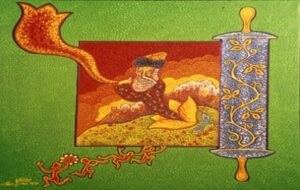בס”ד
By Rabbi Moshe Goodman, Kollel Ohr Shlomo, Hebron

This parsha Haazinu, which means to listen, is always adjacent to Yom Kippur, the day we listen to our
souls, the day we listen to the internal call of Hashem unto our souls. Indeed, the central figure in this
painting is sounding the shofar, which calls the soul to listen to the call of God. There is a parralellism
between the four branches with petals in the blue scroll-cover and the four dancing hasidim underneath
the scroll. Some of these hasidim are playing the shofar and a timbrel, a matter that that reflects the verse
“praise Hashem with the sound of the shofar, praise Hashem with a timbrel.” Then, there is a fifth hasid
emerging from the fifth branch with petals inside the scroll. This matter seems to hint to the theme of the
number five in Yom Kippur, which has five prayers and five types of afflictions. The final prayer of Neila,
when we ask explicitly to be sealed for life, has a special status, apparently paralleling the fifth special
figure and branch depicted here. The unison of the man and the branch, which is essentially a growth
from the earth man was created from, reflects the creation of man on Rosh Hashana, when blowing the
shofar is the primary commandment. The shofar is also sounded on Yom Kippur on the Jubilee year [and
also customarily in many congregations every year]. Then, we also see the shofar which reflects “the
breath of life” that comes from Hashem blown into the earth in the creation of man. We see this man
blowing the shofar amidst the mountain of Jerusalem. This reflects the verse “on that day a shofar shall be
blown and the lost in Ashur shall come and the exiled in Egypt, and they shall prostrate themselves before
Hashem in the holy mountain in Jerusalem.” Jerusalem also corresponds to the shofar of the Jubilee year
sounded on Yom Kippur, since Jerusalem, the holy ground of the Holy Presence” stands as the
continuation of the “holy ground” of Mount Sinai where the “horn of the Jubilee” was first sounded.
Note also that the vision of Yehezkel on the third Temple was received on Yom Kippur, day of the Jubilee
shofar-sounding. Hebron, the sister-city of Jerusalem, according to the Arizal, also reflects this idea,
Hebron has the letters Horeb Nun, suggesting Mount Sinai called Horeb, and the fiftieth and highest gate,
associated with the Divine beyond the more limited reality.
Note also that the scroll here is one-sided. This is customary in Purim Megila, not in a Torah scroll. This
matter may reflect what the Tikunei Zohar says that Yom Kippurim is the “day” like – “ke” – Purim, I.e
Yom Kippur is “like” the holiday of Purim. This idea is very deep and its discussion is beyond our scope
here. However, we will suffice, in context of this painting, by saying that purim means lots and also Yom
Kippur has lots for the goats, one to Hashem and one to Azazel. The lot represents the raising of
consciousness and decision to the supreme Divine Providence beyond our perception. This is a common
theme in both the miracle of Purim, when all was reversed, beyond all reason, in favor of Israel, and the
miracle of Yom Kippur, when, through repentance, even the intentional sins are reversed to become
virtues upon Israel. This is the amazing power of repentance, which pre-dated the creation of this world,
through which one reaches the realms beyond the limits of reason and earthly reality, elevating to the
emancipating call of the Divine soul to be purified before Hashem.



